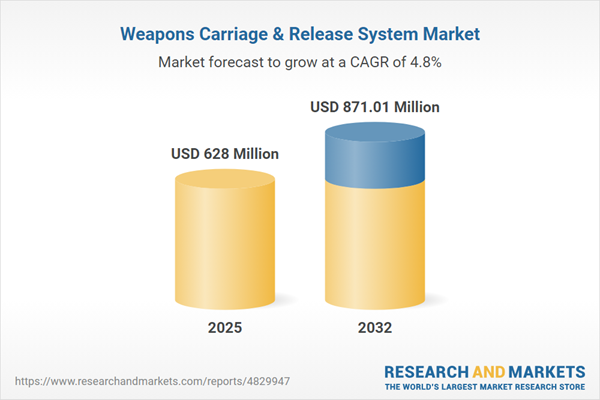Speak directly to the analyst to clarify any post sales queries you may have.
The Weapons Carriage & Release System Market is central to defense modernization, enabling integrated operational flexibility and security across evolving military and selective commercial platforms. This market report offers strategic insights for senior decision-makers driving organizational resilience and performance within complex mission environments.
Market Snapshot: Weapons Carriage & Release System Market Dynamics
The global Weapons Carriage & Release System Market is experiencing accelerated transformation, influenced by technological innovation and changing threat landscapes. Technical advancements are enhancing air, naval, and unmanned systems, while digitalization strengthens interoperability across platforms. Modular architectures support versatility, adapting to diverse mission requirements. As security challenges intensify worldwide, procurement objectives align with adaptable, integrated systems that reinforce readiness. The market’s expanding influence now includes selective commercial applications, supporting essential modernization across the broader defense sector.
Scope & Segmentation
- Platform Types: Solutions enable fixed-wing aircraft—including fighters, trainers, and transport planes—to fulfill a broad set of operational requirements. Helicopters and UAVs utilize dedicated carriage and release systems, supporting specific tactical and endurance demands for both defense and commercial fleet expansion.
- System Types: Product spectrum covers rotary and single bomb racks, advanced ejection mechanisms, and missile launch assemblies, designed for versatile internal or external mounting and swift reconfiguration.
- Technology Adoption: Market uptake spans digital fire-control modules, modern hydraulic actuators, and precision-engineered mechanical solutions, increasing operational reliability while ensuring compatibility with both legacy and upgraded aircraft.
- Application Areas: Military aviation, naval force projection, aerial test and certification, as well as selective commercial logistics, depend on secure deployment solutions calibrated for platform-specific risk and safety protocols.
- Geographic Coverage: The Americas, Europe, Middle East & Africa, and Asia-Pacific each present unique dynamics, shaped by regional regulations, supply resilience frameworks, and evolving market entry considerations.
- Key Company Profiles: Sector progress is underpinned by organizations including Collins Aerospace, BAE Systems plc, Safran S.A., Leonardo S.p.A., Parker-Hannifin Corporation, Moog Inc., Thales S.A., Saab AB, Honeywell International Inc., and L3Harris Technologies, Inc. These companies advance integration, innovation, and global competitiveness across the market.
Key Takeaways for Senior Decision-Makers
- Digitally managed weapon system platforms improve agility, allowing for rapid mission reconfiguration based on operational needs with minimal maintenance.
- Advanced alloys and composites now underpin increased payload flexibility, supporting broader deployment scenarios and platform compatibility for defense and selective non-military purposes.
- Enhancing local sourcing strategies and diversifying supplier networks protect against global logistical risks and variable regulatory conditions, empowering sustained supply reliability.
- Modular, open design architectures help control upgrade investment by streamlining the incorporation of future technology advancements and facilitating straightforward system integration.
- Efforts to ensure interoperability strengthen collective defense operations, increasing joint mission effectiveness and facilitating smoother allied cooperation.
- Direct supplier engagement and partnering with system integrators maximizes deployment performance, especially under demanding operational conditions where resilience is critical.
Tariff Impact on Market Supply Chains
The introduction of recent U.S. tariffs on defense-related components has added complexity to the global Weapons Carriage & Release System Market’s supply chains. Manufacturers are increasingly forming strategic regional alliances and optimizing upstream operations to accommodate evolving policy requirements. These proactive measures help maintain resilience, reduce potential delays, and ensure steady market access despite regulatory shifts and operational uncertainty.
Methodology & Data Sources
The analysis in this report draws from primary research, including interviews with technical executives and thorough reviews of industry documentation. Regulatory evaluations are incorporated to inform risk analysis, while quantitative forecasting and scenario modeling contribute to strategic guidance for market participants across the sector’s value chain.
Why This Weapons Carriage & Release System Market Report Matters
- Enables organizations to benchmark across platform categories, technology trends, and geographic market zones, aiding in precise resource and capital allocation.
- Prepares supply chain leaders for evolving procurement dynamics and shifting regulations, enhancing agility and adaptability in market operations.
- Equips executive teams with structured frameworks for evaluating prospective partners and guiding efficient, long-term investment strategy.
Conclusion
This comprehensive report provides defense-sector leadership with actionable insights to support informed modernization and procurement strategies. The structured analysis facilitates confident forecasting and positions organizations to meet current and emerging operational demands with clarity.
Additional Product Information:
- Purchase of this report includes 1 year online access with quarterly updates.
- This report can be updated on request. Please contact our Customer Experience team using the Ask a Question widget on our website.
Table of Contents
3. Executive Summary
4. Market Overview
7. Cumulative Impact of Artificial Intelligence 2025
Companies Mentioned
The companies profiled in this Weapons Carriage & Release System market report include:- Collins Aerospace
- BAE Systems PLC
- Safran S.A.
- Leonardo S.p.A.
- Parker-Hannifin Corporation
- Moog Inc.
- Thales S.A.
- Saab AB
- Honeywell International Inc.
- L3Harris Technologies, Inc.
Table Information
| Report Attribute | Details |
|---|---|
| No. of Pages | 199 |
| Published | November 2025 |
| Forecast Period | 2025 - 2032 |
| Estimated Market Value ( USD | $ 628 Million |
| Forecasted Market Value ( USD | $ 871.01 Million |
| Compound Annual Growth Rate | 4.7% |
| Regions Covered | Global |
| No. of Companies Mentioned | 11 |









